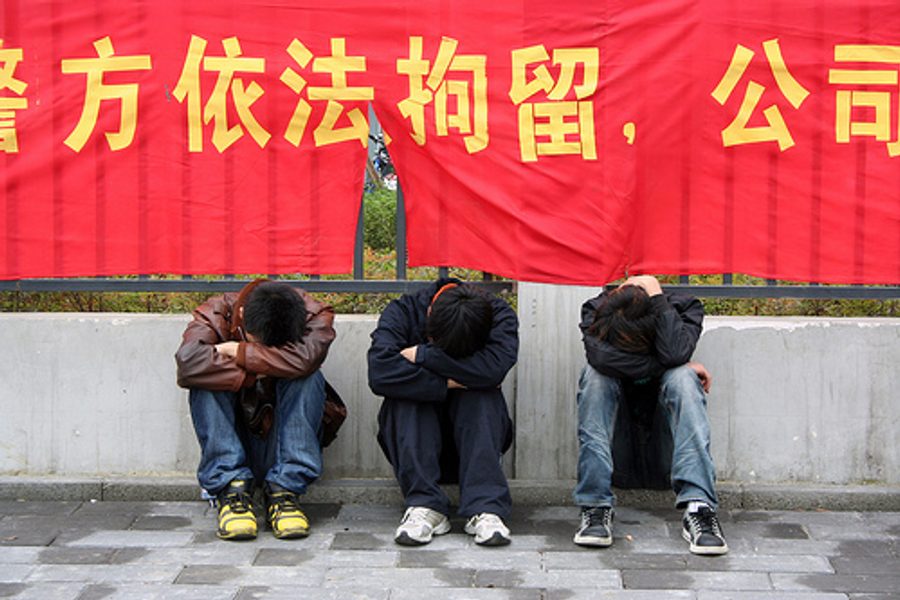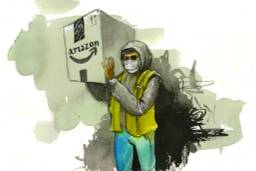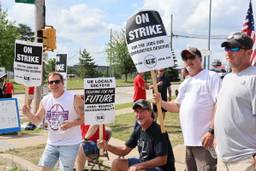
Never underestimate the power of a good public shaming. Western electronics firms were mortified in 2010 by reports of gruesome suicides of young workers in China, employed by the multinational tech giant Foxconn. Since the company runs a network of plants that churn out glistening gadgets for Apple, Dell and Hewlett Packard, the suicides scandalized tech brands that often market themselves as hip and progressive.
The months of damage control that followed led to promises to reform wages and working hours and to establish less Dickensian, more worker-friendly factory conditions. But has all that bad publicity (encapsulated most recently in a sensational theatrical production) paid off for workers?
This week watchdog groups have released a report to kickstart a global campaign to call attention to ongoing labor issues. The “Time to Bite Into a Fair Apple” campaign hopes to keep the pressure on both Chinese authorities and multinational firms to fulfill promises to make the manufacturing system more humane for hundreds of thousands of young Chinese workers.
So far, according to Hong-Kong based Students & Scholars Against Corporate Misbehaviour (SACOM) say progress has been inconsistent and inadequate for many workers along China’s southern coast:
While Apple commends the measures taken by Foxconn to improve working conditions, SACOM finds predicaments of workers remain. Workers always have excessive and forced overtime in order to gain a higher wage. Workers are exposed to dust from construction site and shop floor without adequate protection. Even worse, they are threatened by potential harm of occupational diseases in various departments. Additionally, military-styled management is still in practice, characterized by “military training” for new workers.
A chart outlining the key anticipated reforms catalogues numerous shortcomings. For example, while Apple and Foxconn factory workers were promised across-the-board pay increases, SACOM’s probe of factories and interviews with workers found that workers were still unfairly denied overtime pay and wages were sometimes miscalculated.
While employees were promised protective gear to guard against hazardous exposures in their factories, SACOM’s research revealed that workers did not consistently receive those protections and were “not well informed about the chemicals in use.” There were cases of employers exploiting some young “interns” through their trainee system. Foxconn was also accused of luring in new hires using deceptive recruiting practices.
Despite widely publicized wage hikes (some of which seem less impressive now because they coincided with government-mandated increases in wage standards), young workers reported their income generally fell far short of what might be considered a living wage in tech boom towns like Shenzhen and Chongqing.
Most workers rely on a superhuman overtime schedule to earn enough to survive. For instance, “In Chengdu, workers usually have 80-100 hours overtime work on the top of 174 regular hours per month,” SACOM reports. “This is almost 2-3 times more than the legal limit.”
“Legal limits” don’t appear to be taken very seriously in China’s vast feeder system for cheap migrant labor, however. The report points out that some local government agencies are actively involved in shady recruiting efforts that target eager youth streaming into cities from the outlying villages. By the time the young workers wise up to the real labor situation in these Tayloristic industrial compounds, it is often too late to return to the countryside. If this is the predicament confronting untold numbers of migrant youth today, it’s easy to see how the working conditions prior to the recent spate of promised reforms — which were presumably worse — could have driven some desperate workers to contemplate taking their own lives.
Employers have optimized efficiency with a “continuous shift” system which keeps the machines humming round the clock, with long shifts and minimal breaks. And so the output of iPods and other devices is maximized, and labor costs are externalized to the interchangeable bodies in the form of psychological and physical exhaustion. A 19 year-old worker named Chen Liming expressed anxiety about the harsh oversight of the management:
Some of my roommates weep in the dormitory. I want to cry as well but my tears have not come out.
Perhaps workers don’t want to be seen breaking down during their shift out of fear of retaliation. Or, after a while, they simply may no longer see the point in letting out their frustration. The real danger posed by Foxconn’s labor model is perhaps not so much that it induces misery, but that it disempowers workers to the extent that they are no longer able to feel — just as Apple consumers on the other side of the globe are numb to the pain embedded in their touchscreens.

I hope you found this article important. Before you leave, I want to ask you to consider supporting our work with a donation. In These Times needs readers like you to help sustain our mission. We don’t depend on—or want—corporate advertising or deep-pocketed billionaires to fund our journalism. We’re supported by you, the reader, so we can focus on covering the issues that matter most to the progressive movement without fear or compromise.
Our work isn’t hidden behind a paywall because of people like you who support our journalism. We want to keep it that way. If you value the work we do and the movements we cover, please consider donating to In These Times.
Michelle Chen is a contributing writer at In These Times and The Nation, a contributing editor at Dissent and a co-producer of the “Belabored” podcast. She studies history at the CUNY Graduate Center. She tweets at @meeshellchen.







